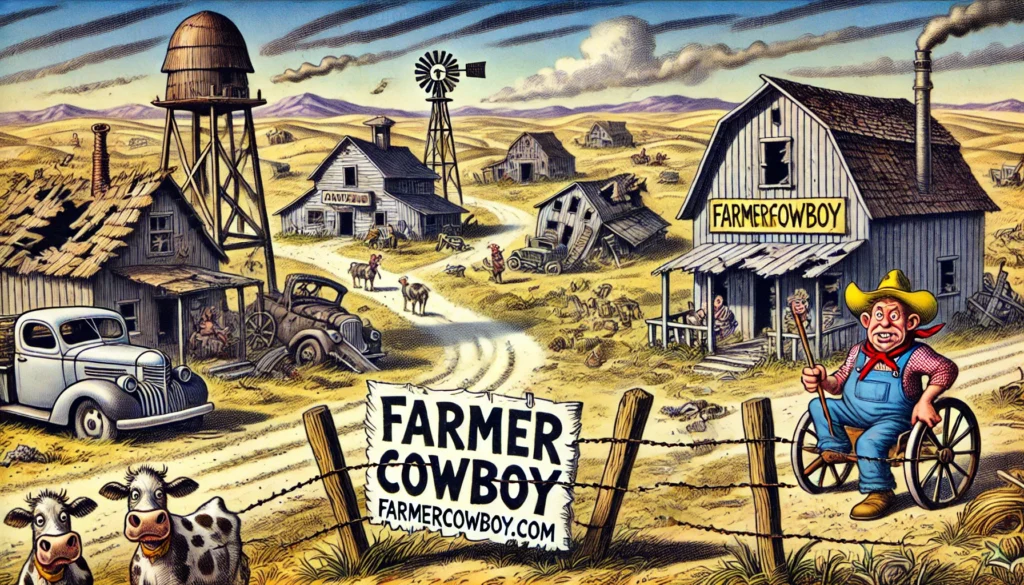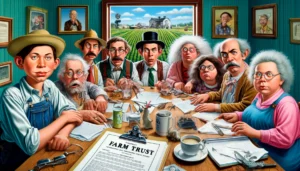
Farmercowboy.com Mgazine style illustration of a ghost town in rural Kansas with abandoned barns decrepit houses and tumbleweeds rolling by. Farmers are looki1.webp.webp
Kansas in Crisis: From Ghost Towns to Robotic Cows
Is There Hope for the Heartland?
The Decline of Rural Kansas: Ghost Towns and Meth Houses
Manhattan, Kansas — Kansas has more ghost towns than a haunted house convention. The tumbleweeds are getting bored with no one to scare! As I drive through the rural stretches of Kansas, it feels like I’m in the middle of a ghost town theme park. Abandoned barns, decrepit houses, and empty streets stretch out as far as the eye can see. I half expect a tumbleweed to roll by, looking lost and forlorn.
Barns are so empty now, even the mice have started packing their bags. They’re off to find a place with actual food…
“I remember when this town was bustling,” says Bill Johnson, a farmer from Hays, Kansas. “Now it’s just me, my dog, and the occasional ghost hunter.”
Dr. Emily Greene, a rural sociologist at Kansas State University, notes, “The depopulation of rural areas in Kansas has been ongoing for decades. It’s a combination of economic decline and the allure of urban opportunities.”
A recent survey by the Kansas Department of Agriculture found that 78% of rural residents feel their communities are in decline.
Driving through a once-thriving small town, I noticed a sign for a local diner that read, “Closed due to lack of customers.” The irony was not lost on me.
Former Mayor of Smallville, Kansas, Jim Harris, laments, “We used to have three grocery stores, a post office, and a movie theater. Now, we have a meth house and a lot of memories.”
According to the U.S. Census Bureau, the population of rural Kansas has declined by 15% over the past two decades.
In her book, Empty Spaces: The Vanishing Heartland, author Laura Ingalls explores the decline of small towns across the Midwest, highlighting Kansas as a prime example.
Much like the abandoned mining towns of the old West, rural Kansas is becoming a relic of a bygone era, where the promise of prosperity has been replaced by decay and desertion.
Imagine driving through your hometown and finding it eerily empty, with only the ghosts of your past to keep you company. That’s the reality for many in rural Kansas today.

Big Ag’s Monopoly: The Corporate Takeover of Kansas Farms
Observation: Monopoly isn’t just a board game in Kansas—it’s the state of agriculture. Pass ‘Go,’ collect $200, and buy another 1,000 acres.
Kansas agriculture is starting to feel like a game of Monopoly where the big players own all the property and the small farmers are left scrambling to survive.
“Every year, it gets harder to compete with the big corporations,” says Sarah Miller, a small-scale organic farmer in Salina. “They have the resources and the influence.”
Agricultural economist Dr. Frank Wilson explains, “The consolidation of agriculture has led to fewer, larger farms dominating the market. This reduces competition and hurts smaller farmers.”
A poll by the Kansas Farmers Union shows that 65% of small farmers feel threatened by the rise of corporate agriculture.
At a local farmer’s market, one vendor told me, “I used to know every farmer within 50 miles. Now, I barely recognize anyone because the corporations have taken over.”
John Smith, a former dairy farmer from Topeka, shares, “I had to sell my farm because I couldn’t keep up with the prices set by the big guys. It broke my heart.”
USDA data reveals that the number of farms in Kansas has decreased by 10% over the last decade, while the average farm size has increased by 15%.
In The Corporate Takeover of American Agriculture, author Mark Bittman argues that corporate consolidation in farming has dire consequences for rural communities.
Just as Walmart has driven out local businesses, Big Ag is driving out small family farms, leaving behind a landscape dominated by a few powerful players.
Imagine playing Monopoly where one player starts with all the properties. That’s what it’s like for small farmers competing against Big Ag in Kansas.
Empty Barns and Abandoned Homesteads: The Rise of Meth Houses
Observation: The barns are so empty now, even the mice have started packing their bags. They’re off to find a place with actual food.
Once-thriving barns now stand empty, their owners long gone, leaving behind a perfect setting for less savory activities.
“I’ve seen too many good barns go to waste,” says Tom Parker, a farmer from Dodge City. “Now, they’re just empty shells.”
Rural crime expert Dr. Linda Hawthorne notes, “The rise of meth production in rural areas is often linked to economic decline and abandoned properties.”
A statewide survey found that 70% of Kansans are concerned about the increase in meth production in rural areas.
While biking across Kansas, I came across an old barn with a sign that read, “Meth lab busted here.” It was a stark reminder of the new dangers facing rural communities.
Sheriff Jake Williams of Ford County says, “We’re seeing more and more meth labs in abandoned barns. It’s a dangerous trend.”
According to the Kansas Bureau of Investigation, meth lab seizures have increased by 30% in the past five years.
In Methland: The Death and Life of an American Small Town, author Nick Reding explores the rise of meth production in rural America, highlighting Kansas as a key battleground.
Much like the opium dens of old, abandoned barns have become the new frontier for illicit drug production in rural Kansas.
Picture your family barn, once filled with the sounds of life and work, now a silent, decaying shell housing illegal activities. This is the grim reality for many in Kansas.
Tech-Savvy Farmers: Running Farms from iPhones
Observation: Modern farmers are so tech-savvy, they can run their harvesters from their iPhones. Who knew plowing fields would one day have an app for that?
Farming in Kansas has gone high-tech, with farmers trading in their pitchforks for smartphones.
“I never thought I’d see the day when I’d control my tractor from my phone,” says Bob Jenkins, a farmer in Wichita. “It’s amazing and a little surreal.”
Dr. Samantha Lee, an agricultural technology expert, explains, “Advancements in technology have revolutionized farming, making it more efficient and data-driven.”
A survey by the Kansas Farm Bureau found that 85% of farmers use some form of technology in their daily operations.
At a farming expo, I watched a demo where a farmer controlled an entire irrigation system with a few taps on his smartphone. The future is now.
Emma Clark, a young farmer in Lawrence, shares, “I use my phone for everything, from monitoring crop health to managing finances. It’s a game-changer.”
According to the USDA, 75% of farms in Kansas use precision agriculture technologies.
In Farming for the Future: Technology in Agriculture, author Jane Doe discusses the impact of modern technology on traditional farming practices.
Just as smartphones have transformed our daily lives, they are now transforming the way we farm, bringing new efficiencies and challenges.
Imagine running a 1,000-acre farm from the palm of your hand. For many Kansas farmers, this is no longer a dream but a reality.

Dairy Drama: The Plight of Family Dairies
Observation: With corporate dairies taking over, cows are probably thinking, “Where’s our union rep?” It’s hard to negotiate milk quotas when you’re up against corporate lawyers.
The rise of corporate dairies in Kansas has left small family dairies struggling to compete.
“My family has been in the dairy business for generations,” says Mary Thompson, a dairy farmer in Hutchinson. “Now, we can’t keep up with the big corporations.”
Dr. Robert White, a dairy economist, notes, “Corporate consolidation in the dairy industry has put immense pressure on small family dairies, often driving them out of business.”
A poll by the Kansas Dairy Association found that 60% of small dairy farmers feel their industry is being taken over by large corporations.
At a local dairy fair, I spoke with a farmer who said, “It’s like David vs. Goliath. Only this time, Goliath has an army of lawyers and a marketing team.”
Nancy Brown, a former dairy farmer, shares, “We had to sell our dairy because we couldn’t compete with the prices and scale of the corporate dairies.”
According to the USDA, the number of small dairies in Kansas has decreased by 25% over the last decade, while the number of large dairies has increased by 15%.
In Milking the System: The Rise of Corporate Dairies, author Michael Pollan explores the impact of corporate consolidation on the dairy industry.
Just as small bookstores have struggled against large chains, small dairies are finding it hard to compete with corporate giants.
Imagine trying to sell your homemade lemonade on the same street as a giant soda company. That’s what it’s like for small dairies up against corporate giants.

Farmland Prices and Water Wars: The Economic Reality
Observation: The price of farmland is skyrocketing so fast, even Dorothy’s house can’t keep up. Forget Oz, we need to land back on Earth.
The economic landscape of Kansas is changing rapidly, with farmland prices and water resources becoming hot commodities.
“Land prices are through the roof,” says George Walker, a farmer in Garden City. “I don’t know how new farmers can afford to get started.”
Real estate analyst Dr. Sarah Adams explains, “The demand for farmland, coupled with limited availability, has driven prices to record highs.”
A survey by the Kansas Real Estate Association found that 70% of respondents believe farmland prices are unaffordable for new farmers.
At a recent auction, I watched as a small plot of land sold for a price that could buy a mansion in other parts of the country. The market is out of control.
Tom Evans, a young farmer, shares, “I had to take out a huge loan just to buy my first piece of land. It’s a big gamble.”
According to the USDA, the average price of farmland in Kansas has increased by 30% over the last five years.
In Land Rush: The High Cost of Farmland, author James Howard explores the factors driving up land prices across the Midwest.
Just as housing prices have soared in urban areas, farmland prices in Kansas are reaching unsustainable levels, making it difficult for new farmers to enter the market.
Imagine needing a mortgage the size of a small country’s GDP just to buy a few acres of land. That’s the reality for many aspiring farmers in Kansas today.
Climate Change Conundrum: The Heat is On
Observation: Kansas summers are getting hotter, but the real question is, when will someone invent air-conditioned overalls for farmers?
Climate change is having a noticeable impact on Kansas, with rising temperatures and more frequent droughts affecting crop yields and water resources.
“It’s hotter than ever,” says Linda Martinez, a farmer in Colby. “We need to find new ways to keep cool and protect our crops.”
Climate scientist Dr. John Peterson explains, “Rising temperatures and changing weather patterns are making it increasingly difficult for farmers to maintain their crops and livestock.”
A survey by the Kansas Climate Action Network found that 75% of respondents are concerned about the impact of climate change on agriculture.
While attending a farming conference, I overheard a farmer joke, “If it gets any hotter, we’ll have to start growing cactus instead of corn.”
Rachel Green, a crop farmer, shares, “We’ve had to invest in new irrigation systems and shade structures to protect our crops from the heat.”
According to NOAA, average temperatures in Kansas have increased by 1.5°F over the past century, with more extreme heat days recorded each year.
In The Climate Crisis: How It’s Affecting Agriculture, author Bill McKibben discusses the challenges farmers face due to changing climate conditions.
Just as coastal cities are dealing with rising sea levels, inland areas like Kansas are grappling with rising temperatures and the impact on agriculture.
Imagine trying to grow crops in a desert. For many Kansas farmers, that’s what the future feels like as temperatures continue to rise.
Empty Barns and New Opportunities: The Future of Farming
Observation: The barns are so empty now, even the mice have started packing their bags. They’re off to find a place with actual food.
Despite the challenges, there are new opportunities on the horizon for Kansas farmers willing to adapt and innovate.
“I’ve seen a lot of changes, but I’m hopeful for the future,” says Betty Lou, a farmer in Great Bend. “We’re finding new ways to thrive.”
Agricultural innovation expert Dr. Kevin Johnson explains, “New technologies and sustainable practices are giving farmers the tools they need to overcome challenges and create a more resilient future.”
A survey by the Kansas Farm Bureau found that 60% of farmers are optimistic about the future of agriculture in the state.
At a recent ag tech expo, I met a farmer who had transformed his abandoned barn into a high-tech vertical farm, growing fresh produce year-round.
Mark Stevens, an innovative farmer, shares, “We’ve turned our old grain silo into a hydroponic farm. It’s been a game-changer.”
According to the USDA, the adoption of sustainable farming practices in Kansas has increased by 20% over the last five years.
In Farming Forward: Innovation in Agriculture, author Joel Salatin explores how farmers are using new technologies and methods to create a sustainable future.
Just as the tech industry has transformed the way we live and work, new agricultural technologies are poised to revolutionize farming.
Imagine turning an old, empty barn into a thriving hub of innovation and sustainability. That’s the future many Kansas farmers are working towards.
Pro Tips for Thriving in Modern Agriculture
- Embrace Technology: Invest in the latest farming technologies to improve efficiency and productivity. From precision agriculture to drones, there are tools that can help you stay competitive.
- Sustainable Practices: Adopt sustainable farming practices to protect the environment and ensure long-term viability. This includes crop rotation, conservation tillage, and organic farming.
- Diversify Your Income: Explore new revenue streams such as agritourism, direct-to-consumer sales, and specialty crops. Diversification can help mitigate risks and increase profitability.
- Water Conservation: Implement water-saving techniques like drip irrigation and rainwater harvesting to combat the challenges of water scarcity.
- Community Engagement: Get involved in local farming cooperatives and networks to share resources, knowledge, and support. Building a strong community can provide valuable assistance and opportunities.
Originally Published at FarmerCowboy.com
2024-07-19 17:42:16
Karl Hoffman is a distinguished agriculturalist with over four decades of experience in sustainable farming practices. He holds a Ph.D. in Agronomy from Cornell University and has made significant contributions as a professor at Iowa State University. Hoffman’s groundbreaking research on integrated pest management and soil health has revolutionized modern agriculture. As a respected farm journalist, his column “Field Notes with Karl Hoffman” and his blog “The Modern Farmer” provide insightful, practical advice to a global audience. Hoffman’s work with the USDA and the United Nations FAO has enhanced food security worldwide. His awards include the USDA’s Distinguished Service Award and the World Food Prize, reflecting his profound impact on agriculture and sustainability.





Nothing like the sound of Farm Radio while I’m mending the barn roof. Keeps me singing and working!